Climatology of the Linke and Unsworth–Monteith Turbidity Parameters for Greece: Introduction to the Notion of a Typical Atmospheric Turbidity Year
Abstract
1. Introduction
2. Materials and Methods
2.1. Methodology
2.1.1. Calculation of the Linke Turbidity Factor, TL
2.1.2. Calculation of the Unsworth–Monteith Turbidity Coefficient, TUM
2.1.3. Classification of the Sky Conditions
2.2. Data Collection
2.3. Data Processing
3. Results
3.1. TL and TUM Variation: Month–Hour Diagrams for All-Sky Conditions
3.2. TL and TUM Variation: Month–Hour Diagrams for Clear-Sky Conditions
3.3. Variation of k’d vs. k’t over Greece
3.4. Intra-Annual Variation of TL and TUM
3.5. Maps of Annual Mean TL and TUM
3.6. Variation of TUM vs. TL over Greece
4. Conclusions
Author Contributions
Funding
Acknowledgments
Conflicts of Interest
Nomenclature
| Greek symbols | |
| α | Ångström exponent (dimensionless) |
| β | Ångström turbidity coefficient (dimensionless) |
| γ | Solar elevation or solar height or solar altitude (degrees) |
| λ | Geographical longitude (degrees, positive in east of Greenwich) |
| φ | Geographical latitude (degrees, positive in Northern Hemisphere) |
| Latin symbols | |
| B | Schüepp turbidity factor (dimensionless) |
| Be | Direct horizontal irradiance (Wm−2) |
| B*e | Direct (normal) irradiance in a dust-free atmosphere (Wm−2) |
| D | Day of the year (dimensionless); D = 1 for 1 January, 365 for 31 December in a non-leap year and 366 in a leap year |
| De | Diffuse horizontal irradiance (Wm−2) |
| em | Partial water-vapor pressure (hpa) |
| es | Saturation water-vapor pressure (hpa) |
| Ge | Global horizontal irradiance (Wm−2) |
| Ge,extra | Extra-terrestrial solar irradiance (Wm−2) = S Ge,o |
| Ge,o | Solar constant = 1361.1 Wm−2 |
| m | Optical air mass (dimensionless) |
| m’ | Pressure-corrected optical air mass (dimensionless) |
| Mean attenuation of the direct solar radiation due to Rayleigh scattering (dimensionless) | |
| kd | Diffuse fraction (dimensionless) |
| k’d | Modified diffuse fraction (dimensionless) |
| kt | Clearness index (dimensionless) |
| k’t | Modified clearness index (dimensionless) |
| Po | Sea-level atmospheric pressure = 1013.25 hpa |
| Pz | Atmospheric pressure at height z (hpa) |
| RH | Relative humidity (%) |
| S | Correction of the Earth–Sun distance (dimensionless) |
| Ti | Atmospheric transmittance due to ith atmospheric constituent (dimensionless) |
| TL | Linke turbidity factor (dimensionless) |
| t | Ambient temperature (K) = 273.15 + t’ |
| t’ | Ambient temperature (°C) |
| TUM | Unsworth–Monteith turbidity coefficient (dimensionless) |
| ui | Atmospheric column content due to ith atmospheric constituent (atm-cm, or cm, depending on the constituent) |
| z | Altitude (m) |
References
- Iqbal, M. An Introduction to Solar Radiation; Academic Press: Toronto, ON, Canada, 1983. [Google Scholar]
- Ångström, A. On the atmospheric transmission of sun radiation and dust in the air. Georg. Ann. 1929, 2, 156–166. [Google Scholar]
- Ångström, A. Techniques of determining the turbidity of the atmosphere. Tellus 1961, 13, 214–223. [Google Scholar] [CrossRef]
- Ångström, A. Parameters of atmospheric turbidity. Tellus 1964, 16, 64–75. [Google Scholar] [CrossRef]
- Schüepp, W. Die bestimmung der komponenten der atmosphärischen turbung aus aktinometermessungen. Arch. Meteorol. Geophys. Bioklim. 1949, B1, 257–317. [Google Scholar] [CrossRef]
- Linke, F. Transmissionkoefzient und Trübungsfaktor. Beitr. Phys. Frei Atmos. 1922, 10, 91. [Google Scholar]
- Linke, F. Messungen der sonnestrahlung beivier freiballonfahrten. Beitr. Phys. Frei Atmos. 1929, 15, 176. [Google Scholar]
- Unsworth, M.H.; Monteith, J.L. Aerosol and solar radiation in Britain. Q. J. R. Meteorol. Soc. 1972, 98, 778–797. [Google Scholar] [CrossRef]
- Polavarapu, R.J. Atmospheric turbidity over Canada. J. Appl. Meteorol. 1978, 17, 1368–1374. [Google Scholar] [CrossRef][Green Version]
- Abdelrahman, M.A.; Said, A.M.; Shuaib, A.N. Comparison between atmospheric turbidity coefficients of desert and temperate climates. Sol. Energy 1988, 40, 219–225. [Google Scholar] [CrossRef]
- Grenier, J.C.; de la Casinière, A.; Cabot, T. A spectral model of Linke’s turbidity factor and its experimental implications. Sol. Energy 1994, 52, 303–313. [Google Scholar] [CrossRef]
- Eaton, F.D.; Hines, J.R.; Drexler, J.J.; Soules, D.B. Short-term variability of atmospheric turbidity and optical turbulence in a desert environment. Theor. Appl. Climatol. 1997, 56, 67–81. [Google Scholar] [CrossRef]
- Cucumo, M.; Marinalli, V.; Oliveri, G. Experimental data of the Linke turbidity factor and estimates of the Ångström turbidity coefficient for two Italian localities. Renew. Energy 1999, 17, 397–410. [Google Scholar] [CrossRef]
- Diabate, L.; Remund, J.; Wald, L. Linke turbidity factors for several sites in Africa. Sol. Energy 2003, 75, 111–119. [Google Scholar] [CrossRef]
- Zakey, A.S.; Abdelwahab, M.M.; Makar, P.A. Atmospheric turbidity over Egypr. Atmos. Environ. 2004, 38, 1579–1591. [Google Scholar] [CrossRef]
- Hove, T.; Manyumbu, E. Estimates of the Linke turbidity factor over Zimbabwe using ground-measured clear-sky global solar radiation and sunshine records based on a modified ESRA clear-sky approach. Renew. Energy 2013, 52, 190–196. [Google Scholar] [CrossRef]
- Bilbao, J.; Rόman, R.; Miguel, M. Turbidity coefficients from normal direct solar irradiance in central Spain. Atmos. Res. 2014, 143, 73–84. [Google Scholar] [CrossRef]
- Saad, M.; Trabelsi, A.; Masmoudi, M.; Alfaro, S.C. Spatial and temporal variability of the atmospheric turbidity in Tunisia. J. Atmos. Solar-Terr. Phys. 2016, 149, 93–99. [Google Scholar] [CrossRef]
- Ulscka-Kawalkowska, J.; Posyniak, M.; Markowicz, K.; Podgόrski, J. Comparison of the Linke turbidity factor in Warsaw and in Belsk. Bull. Geogr. 2017, 13, 71–81. [Google Scholar] [CrossRef][Green Version]
- Mateos, D.; Cachorro, V.E.; Velasco-Merino, C.; O’Neill, N.T.; Burgos, M.A.; Gonzalez, R.; Toledano, C.; Herreras, M.; Calle, A.; de Frutos, A.M. Comparison of three different methodologies for the identification of high atmospheric turbidity episodes. Atmos. Res. 2020, 237, 104835. [Google Scholar] [CrossRef]
- Karalis, J.D. The turbidity parameters in Athens. Arch. Meteorol. Geophys. Biokl. 1976, 24, 25–34. [Google Scholar] [CrossRef]
- Katsoulis, B.D. Atmospheric turbidity at Athens Observatory. Pure Appl. Geophys. 1977, 115, 583–591. [Google Scholar] [CrossRef]
- Katsoulis, B.D.; Tselepidaki, I.G. Monthly variation and trends of atmospheric turbidity in Athens. Zeich. Meteorol. 1986, 36, 255–258. [Google Scholar]
- Kambezidis, H.D.; Founda, D.H.; Papanikolaou, N.S. Linke and Unsworth-Montheith turbidity parameters in Athens. Q. J. R. Meteorol. Soc. 1993, 119, 367–374. [Google Scholar] [CrossRef]
- Kambezidis, H.D.; Katevatis, E.M.; Petrakis, M.; Lykoudis, S.; Asimakopoulos, D.N. Estimation of the Linke and Unsworth-Montheith turbidity factors in the visible spectrum: Application for Athens, Greece. Sol. Energy 1998, 62, 39–50. [Google Scholar] [CrossRef]
- Kambezidis, H.D.; Fotiadi, A.K.; Katsoulis, B.D. Variability of the Linke and Unsworth-Monteith turbidity parameters in Athens, Greece. Meteorol. Atmos. Phys. 2000, 75, 259–269. [Google Scholar] [CrossRef]
- Jacovides, C.P.; Karalis, J.D. Broad-band turbidity parameters and spectral band resolutions of solar radiation for the period 1954–1991, in Athens, Greece. Int. J. Climatol. 1996, 16, 229–242. [Google Scholar] [CrossRef]
- Sahsamanoglou, H.S. Parameters of atmospheric turbidity in Athens and Thessaloniki. Atmos. Oceanic Opt. 1994, 7, 193–198. [Google Scholar]
- Duffie, J.A.; Beckman, W.A. Solar Engineering of Thermal Processes; J. Wiley: New York, NY, USA, 1980. [Google Scholar]
- Gueymard, C. A re-evaluation of the solar constant based on a42-year total solar irradiance time series and a reconciliation of space borne observations. Sol. Energy 2018, 168, 2–9. [Google Scholar] [CrossRef]
- Kasten, F. Τhe Linke turbidity factor based on improved values of the integral Rayleigh optical thickness. Sol. Energy 1996, 56, 239–244. [Google Scholar] [CrossRef]
- Louche, A.; Simonno, G.; Peri, G.; Iqbal, M. An analysis of Linke turbidity factor. Sol. Energy 1986, 37, 393–406. [Google Scholar] [CrossRef]
- Kasten, F.; Young, A.T. Revised optical air mass tables and approximation formula. Appl. Opt. 1989, 28, 4735–4738. [Google Scholar] [CrossRef]
- Vertical Pressure Variation. Available online: https://en.wikipedia.org/wiki/Vertical_pressure_variation (accessed on 10 May 2020).
- Kasten, F. Elimination of the virtual diurnal variation of the Linke turbidity factor. Meteorol. Rund. 1988, 41, 93–94. [Google Scholar]
- Bird, R.E.; Hulstrom, R.L. Direct Insolation Models; SERI/TR-335-344; Solar Energy Research Institute: Golden, CO, USA, 1980. [Google Scholar]
- Bird, R.E.; Hulstrom, R.L. A Simplified Clear Sky Model for Direct and Diffuse Insolation on Horizontal Surfaces; SERI/TR-642-761; Solar Energy Research Institute: Golden, CO, USA, 1981. [Google Scholar]
- Psiloglou, B.E.; Santamouris, M.; Asimakopoulos, D.N. On the atmospheric water-vapor transmission function for solar radiation models. Sol. Energy 1994, 53, 445–453. [Google Scholar] [CrossRef]
- Psiloglou, B.E.; Santamouris, M.; Asimakopoulos, D.N. Predicting the broadband transmittance of the uniformly-mixed gases (CO2, CO, N2O, CH4 and O2) in the atmosphere for solar radiation models. Renew. Energ. 1995, 6, 63–70. [Google Scholar] [CrossRef]
- Psiloglou, B.E.; Santamouris, M.; Varotsos, C.; Asimakopoulos, D.N. A new parameterisation of the integral ozone transmission. Sol. Energy 1996, 56, 573–581. [Google Scholar]
- Psiloglou, B.E.; Santamouris, M.; Asimakopoulos, D.N. On broadband Rayleigh scattering in the atmosphere for solar radiation modelling. Renew. Energ. 1995, 6, 429–433. [Google Scholar] [CrossRef]
- Psiloglou, B.E.; Santamouris, M.; Asimakopoulos, D.N. Atmospheric broadband model for computation of solar radiation at the Earth’s surface. Application to Mediterranean climate. Pure Appl. Geophys. 2000, 157, 829–860. [Google Scholar] [CrossRef]
- Leckner, B. Spectral distribution of solar radiation at the Earth’s surface-elements of a model. Sol. Energy 1978, 20, 443–450. [Google Scholar] [CrossRef]
- Gueymard, C. Assessment of the accuracy and computing speed of simplified saturation vapour equations using a new reference dataset. J. Appl. Meteorol. 1993, 32, 1294–1300. [Google Scholar] [CrossRef]
- van Heuklon, T.K. Estimating atmospheric ozone for solar radiation models. Sol. Energy 1979, 22, 63–68. [Google Scholar] [CrossRef]
- Karavana-Papadimou, K.; Psiloglou, B.E.; Lykoudis, S.; Kambezidis, H.D. Model for estimating atmospheric ozone content over Europe for use in solar radiation algorithms. Glob. NEST 2013, 15, 152–162. [Google Scholar]
- Kambezidis, H.D. The solar radiation climate of Athens: Variations and tendencies in the period 1992–2017, the brightening era. Sol. Energy 2018, 173, 328–347. [Google Scholar] [CrossRef]
- Reindl, D.T.; Beckman, W.A.; Duffie, J.A. Diffuse fraction correlation. Sol. Energy 1990, 45, 1–7. [Google Scholar] [CrossRef]
- Li, D.H.W.; Lam, J.C. An analysis of climatic parameters and sky condition classification. Build. Environ. 2001, 36, 435–445. [Google Scholar] [CrossRef]
- Li, D.H.W.; Lau, C.C.S.; Lam, J.C. Overcast sky conditions and luminance distribution in Hong Kong. Build. Environ. 2004, 39, 101–108. [Google Scholar] [CrossRef]
- Kuye, A.; Jagtap, S.S. Analysis of solar radiation data for Port Harcourt, Nigeria. Sol. Energy 1992, 49, 139–145. [Google Scholar] [CrossRef]
- Perez, R.; Ineichen, P.; Seals, R.; Michalsky, J.; Zelenka, A. Making full use of the clearness index for parameterizing hourly insolation conditions. Sol. Energy 1990, 45, 111–114. [Google Scholar] [CrossRef]
- Gopinathan, K.K. Estimating the diffuse fraction of hourly global solar radiation in S. Africa. Int. J. Sool. Energy 1980, 7, 39–45. [Google Scholar] [CrossRef]
- Hijazin, M.I. The diffuse fraction of hourly solar radiation for Amman/Jordan. Renew. Energy 1998, 13, 249–253. [Google Scholar]
- Okogbue, E.C.; Adedokun, J.A.; Holmgren, B. Hourly and daily clearness index and diffuse fraction at a tropical station, Ile-Ife, Nigeria. Int. J. Climatol. 2009, 29, 1035–1047. [Google Scholar] [CrossRef]
- Hofmann, M.; Seckmeyer, G. A new model for estimating the diffuse fraction of solar irradiance for photovoltaic system simulations. Energies 2017, 10, 248. [Google Scholar] [CrossRef]
- Kambezidis, H.D.; Psiloglou, B.E.; Kaskoutis, D.G.; Karagiannis, D.; Petrinoli, K.; Garviil, A.; Kavadias, K. Generation of Typical Meteorological Years for 33 locations in Greece: Adaptation to the needs of various applications. Theor. Appl. Climatol. 2020. online first. [Google Scholar] [CrossRef]
- Psiloglou, B.E.; Kambezidis, H.D. Performance of the meteorological radiation model during the solar eclipse of 29 March 2006. Atmos. Chem. Phys. 2007, 7, 6047–6059. [Google Scholar] [CrossRef]
- Kambezidis, H.D. Current trends in solar radiation modelling: The paradigm of MRM. J. Fund. Renew. Energy App. 2016, 6. [Google Scholar] [CrossRef]
- Kambezidis, H.D.; Psiloglou, B.E.; Karagiannis, D.; Dumka, U.C.; Kaskaoutis, D.G. Recent improvements of the Meteorological Radiation Model for solar irradiance estimates under all-sky conditions. Renew. Energy 2016, 93, 142–158. [Google Scholar] [CrossRef]
- Kambezidis, H.D.; Psiloglou, B.E.; Karagiannis, D.; Dumka, U.C.; Kaskaoutis, D.G. Meteorological Radiation Model (MRM v6.1): Improvements in diffuse radiation estimates and a new approach for implementation of cloud products. Renew. Sustain. Energy Rev. 2017, 74, 616–637. [Google Scholar] [CrossRef]
- TOTEE, 2010. Analytical National Parameter Specifications for the Calculation of the Energy Efficiency of Buildings and the Edition of the Energy Efficiency Certificate; Technical Guideline No. 20701-1; Technical Chamber of Greece: Athens, Greece, 2010.
- ELOT, Information and Documentation: Conversion of Greek Characters into Latin Characters; Standard 743; Hellenic Organization for Standardization: Athens, Greece, 2001.
- ISO, Information and Documentation: Conversion of Greek Characters into Latin Characters; Standard 843; International Standardization Organization: Geneva, Switzerland, 1997.
- ASHRAE. International Weather for Energy Calculations (IWEC Weather Files) User’s Manual, version 1.1.; ASHRAE: Atlanta, GA, USA, 2002. [Google Scholar]
- Walraven, R. Calculating the position of the sun. Sol. Energy 1978, 20, 393–397. [Google Scholar] [CrossRef]
- Wilkinson, B.J. An improved FORTRAN program for the rapid calculation of the solar position. Sol. Energy 1981, 27, 67–68. [Google Scholar] [CrossRef]
- Muir, L.R. Comments on “The effect of the atmospheric refraction in the solar azimuth”. Sol. Energy 1983, 30, 295. [Google Scholar] [CrossRef]
- Kambezidis, H.D.; Papanikolaou, N.S. Solar position and atmospheric refraction. Sol. Energy 1990, 44, 143–144. [Google Scholar] [CrossRef]
- Kambezidis, H.D.; Tsangrassoulis, A.E. Solar position and right ascension. Sol. Energy 1993, 50, 415–416. [Google Scholar] [CrossRef]
- Kambezidis, H.D.; Muneer, T.; Tzortzis, M.; Arvanitaki, S. Global and diffuse solar illuminance: Month-hour distribution for Athens, Greece in 1992. Lighting. Res. Technol. 1992, 30, 69–74. [Google Scholar] [CrossRef]
- Pedrόs, R.; Utrillas, M.P.; Martínez-Lozano, J.A.; Tena, F. Values of broad band turbidity coefficients in a Mediterranean coastal site. Sol. Energy 1999, 66, 11–20. [Google Scholar] [CrossRef]
- El-Wakil, S.A.; El-Metwally, M.; Gueymard, C. Atmospheric turbidity of urban and desert areas on the Nile Basin in the aftermath of Mt. Pinatubo’s eruption. Theor. Appl. Climatol. 2001, 68, 89–108. [Google Scholar] [CrossRef]
- Eftimie, E. Linke turbidity factor for Braşov urban area. Bull. Transilv. Univ. Braşov 2009, 2, 61–68. [Google Scholar]
- Kaskaoutis, D.G.; Kosmopoulos, P.G.; Nastos, P.T.; Kambezidis, H.D.; Sharma, M.; Mehdi, W. Transport pathways of sahara dust over Athens, Greece as detected by MODIS and TOMS. Geo. Nat. Haz. Risk 2012, 3, 35–54. [Google Scholar] [CrossRef]
- Jacovides, C.P.; Kaltsounides, N.A.; Giannourakos, G.P.; Kallos, G.B. Trends in attenuation coefficients in Athens, Greece, from 1954 to 1991. J. Appl. Meteorol. 1995, 34, 1459–1465. [Google Scholar] [CrossRef][Green Version]

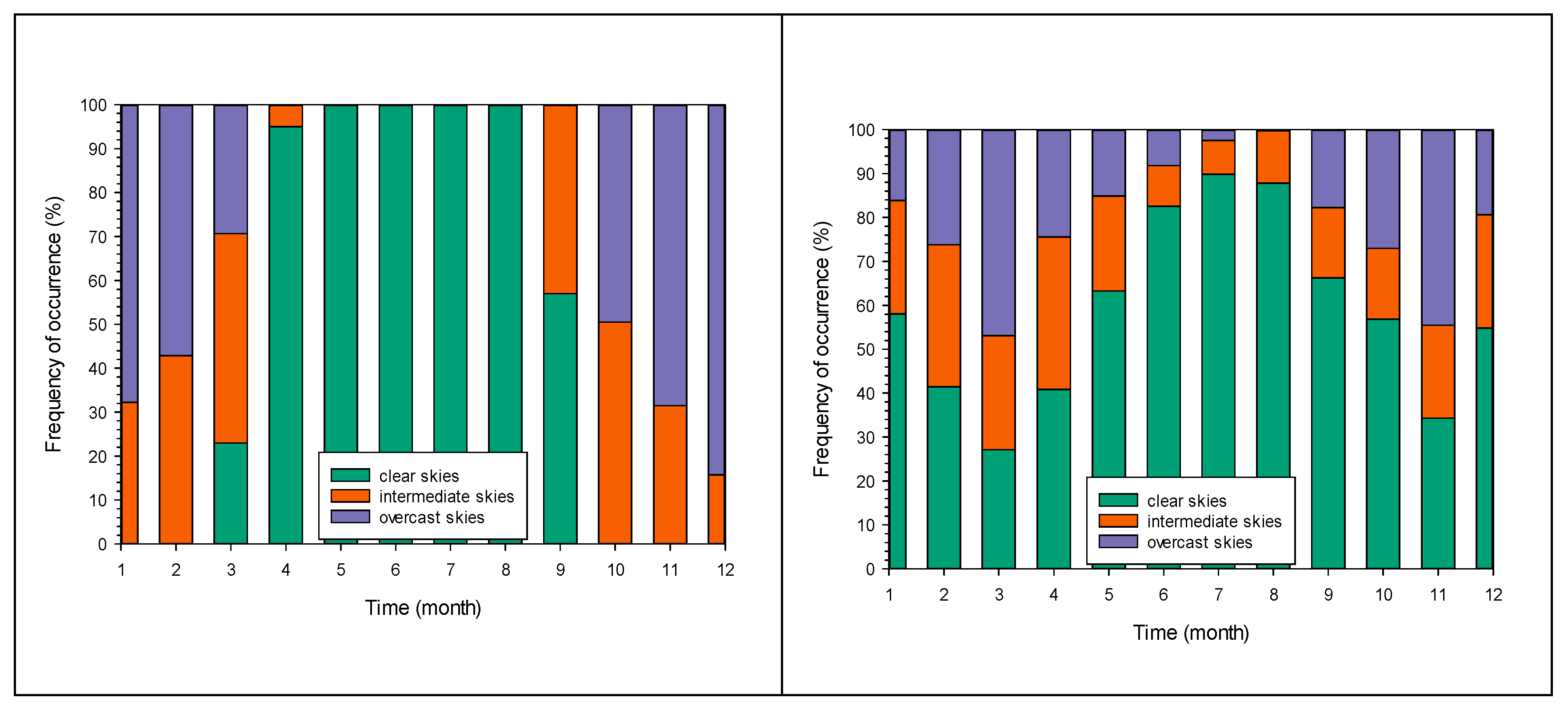


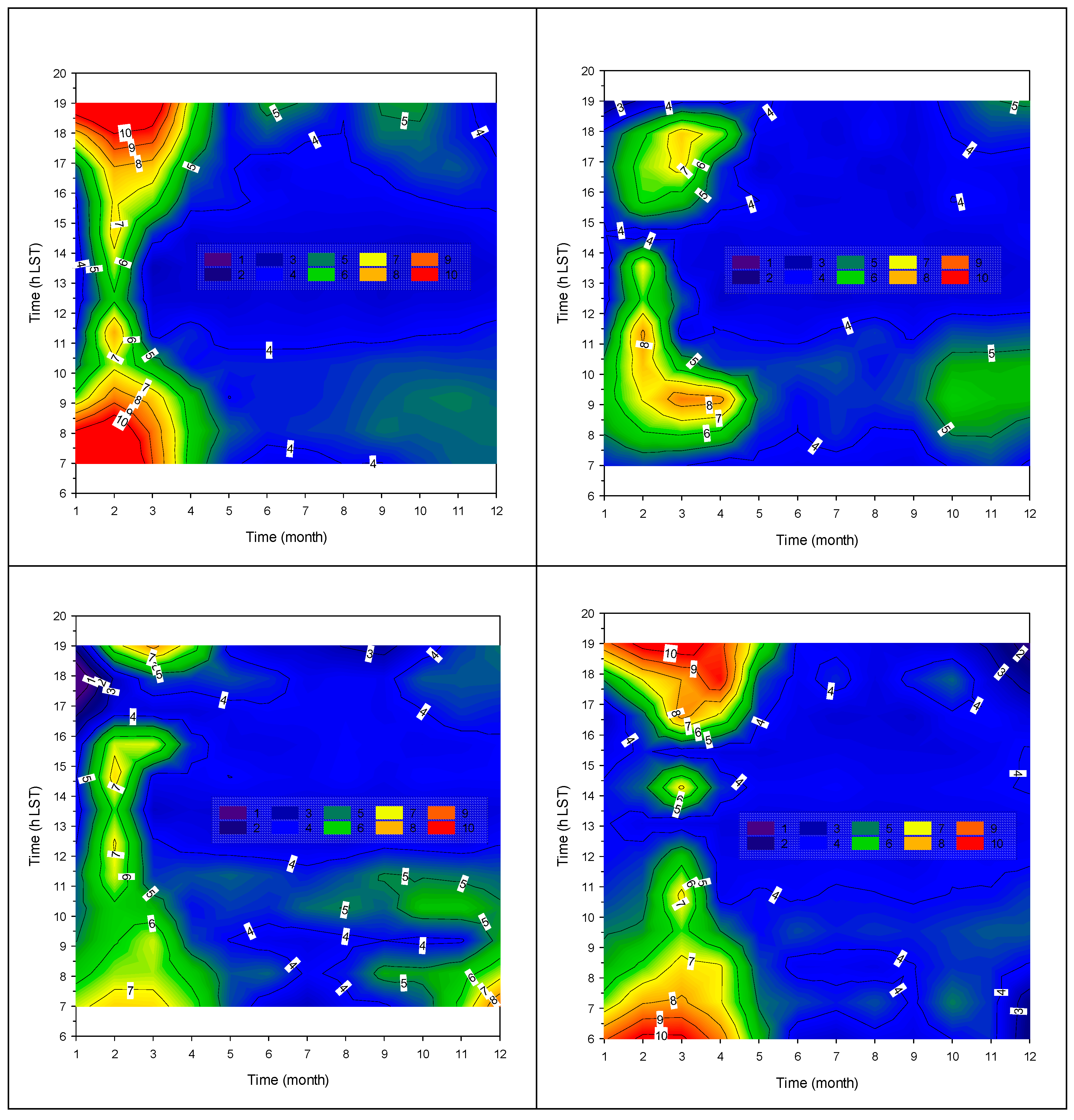

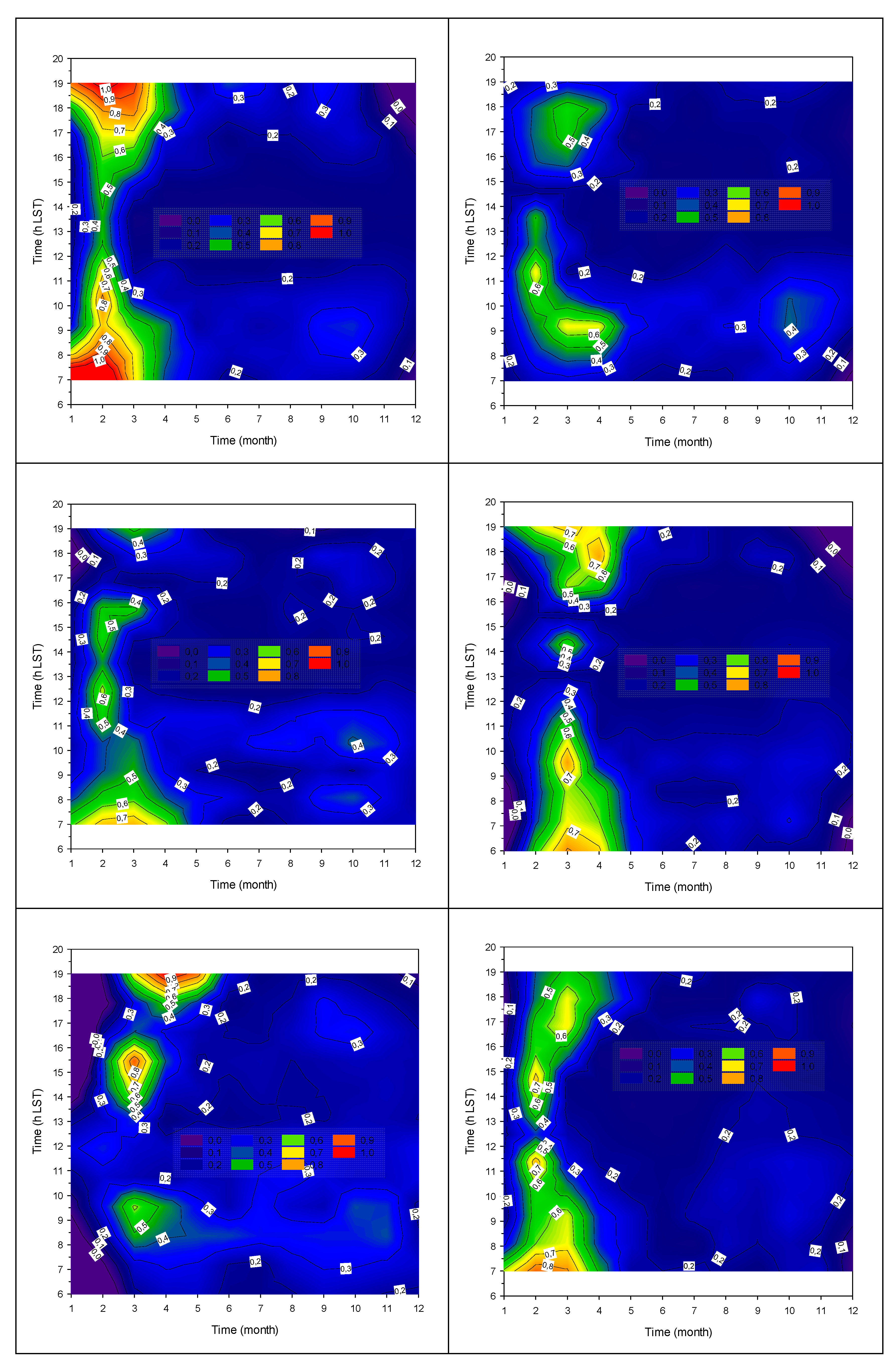
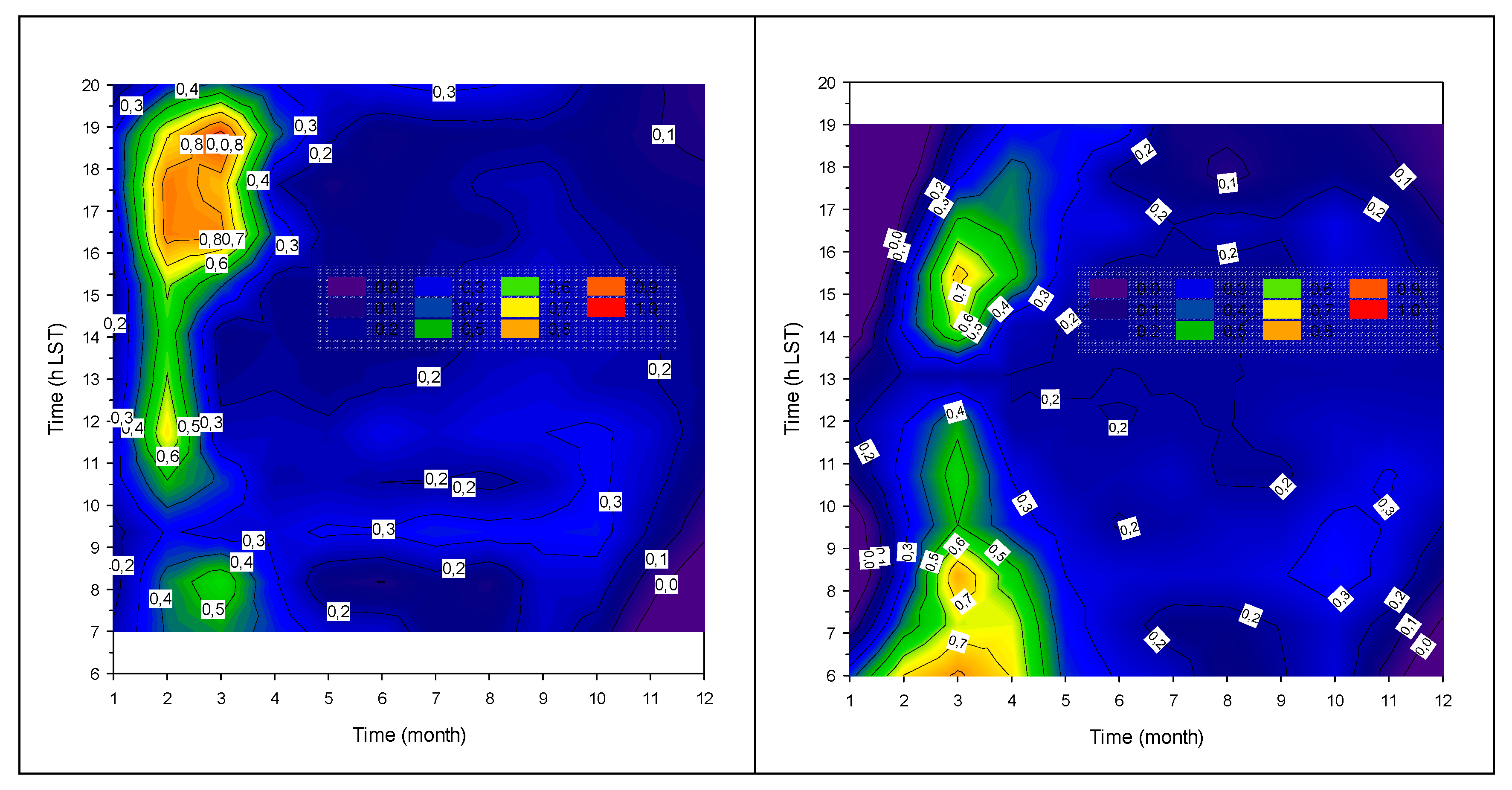


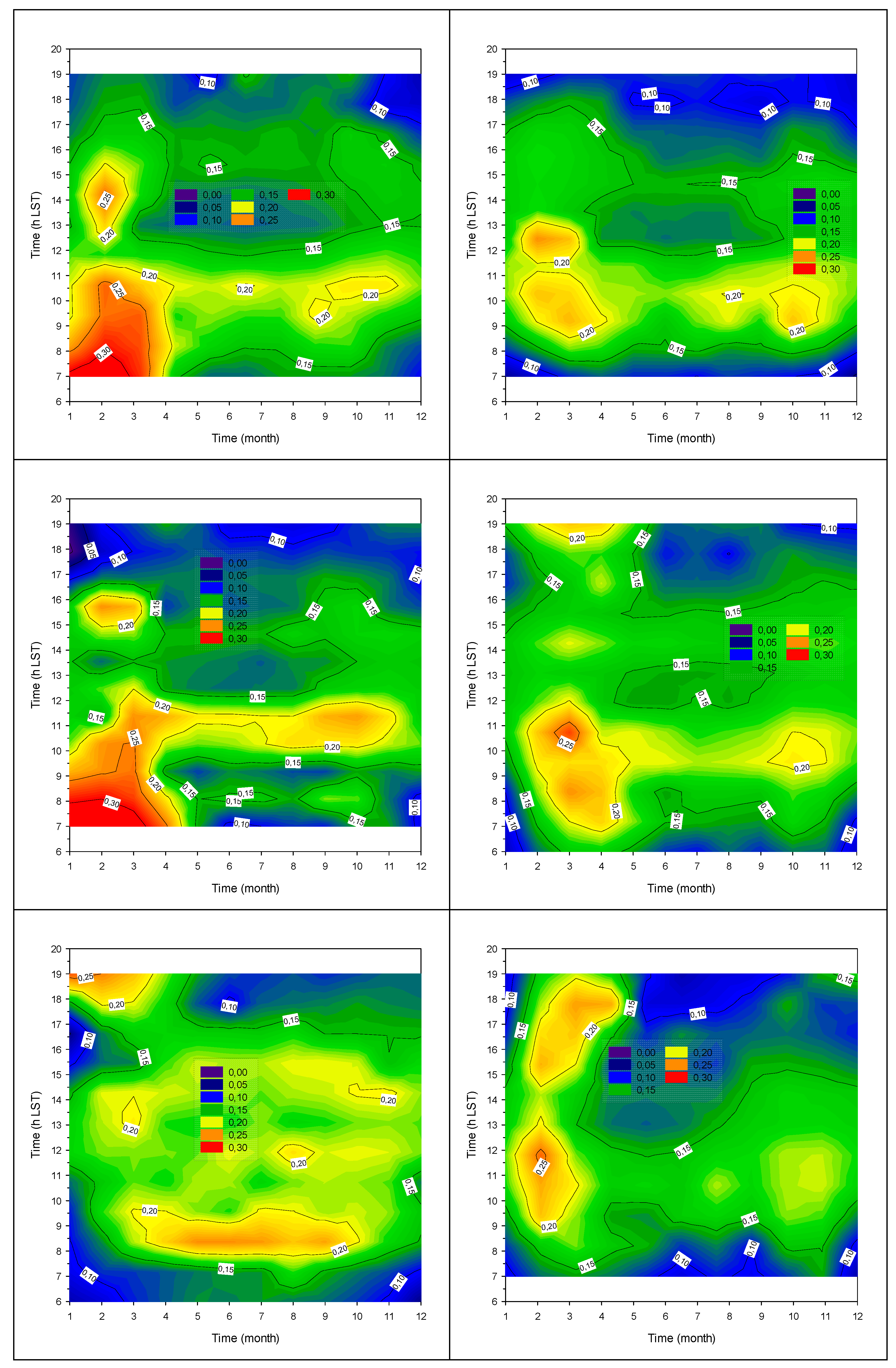

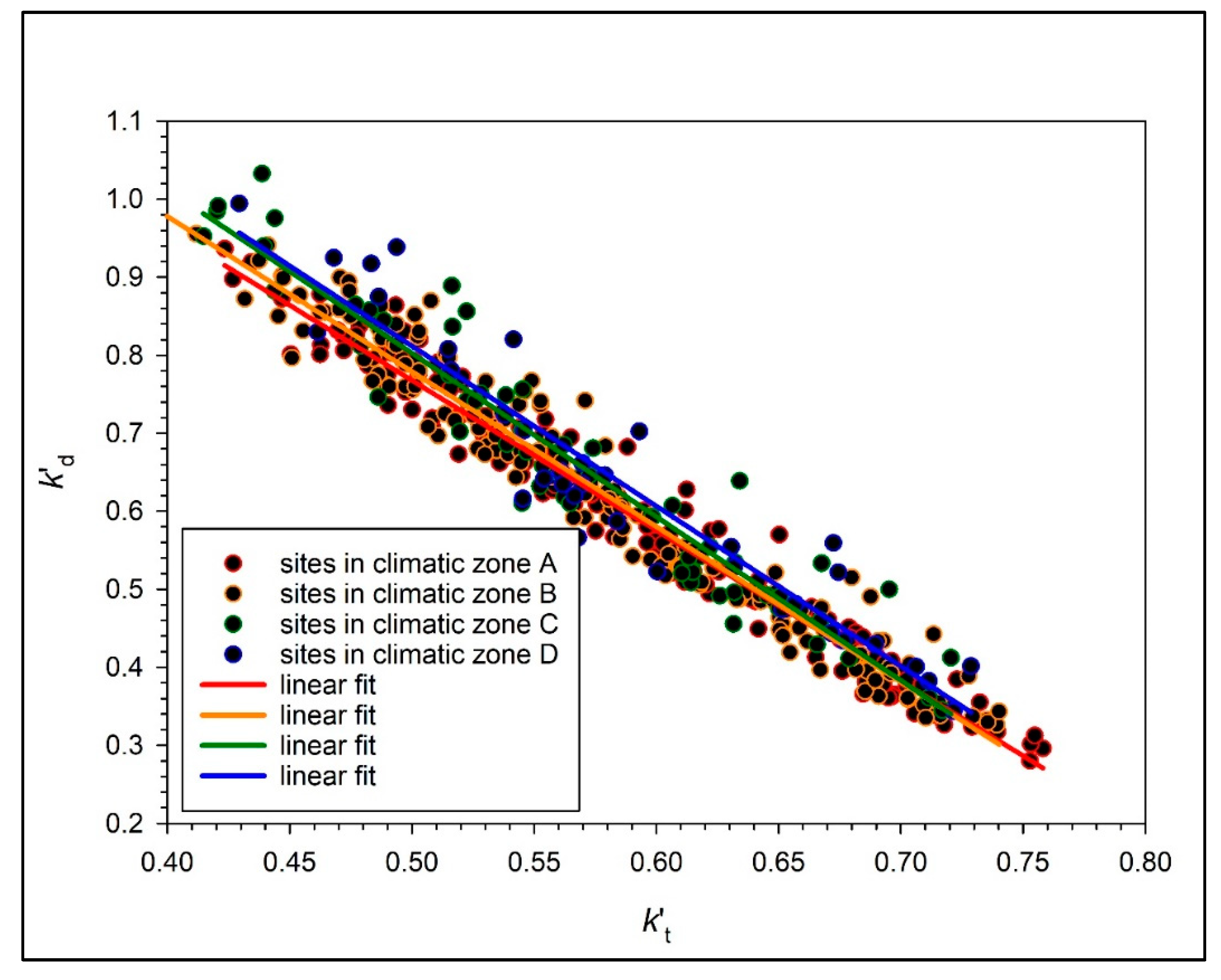
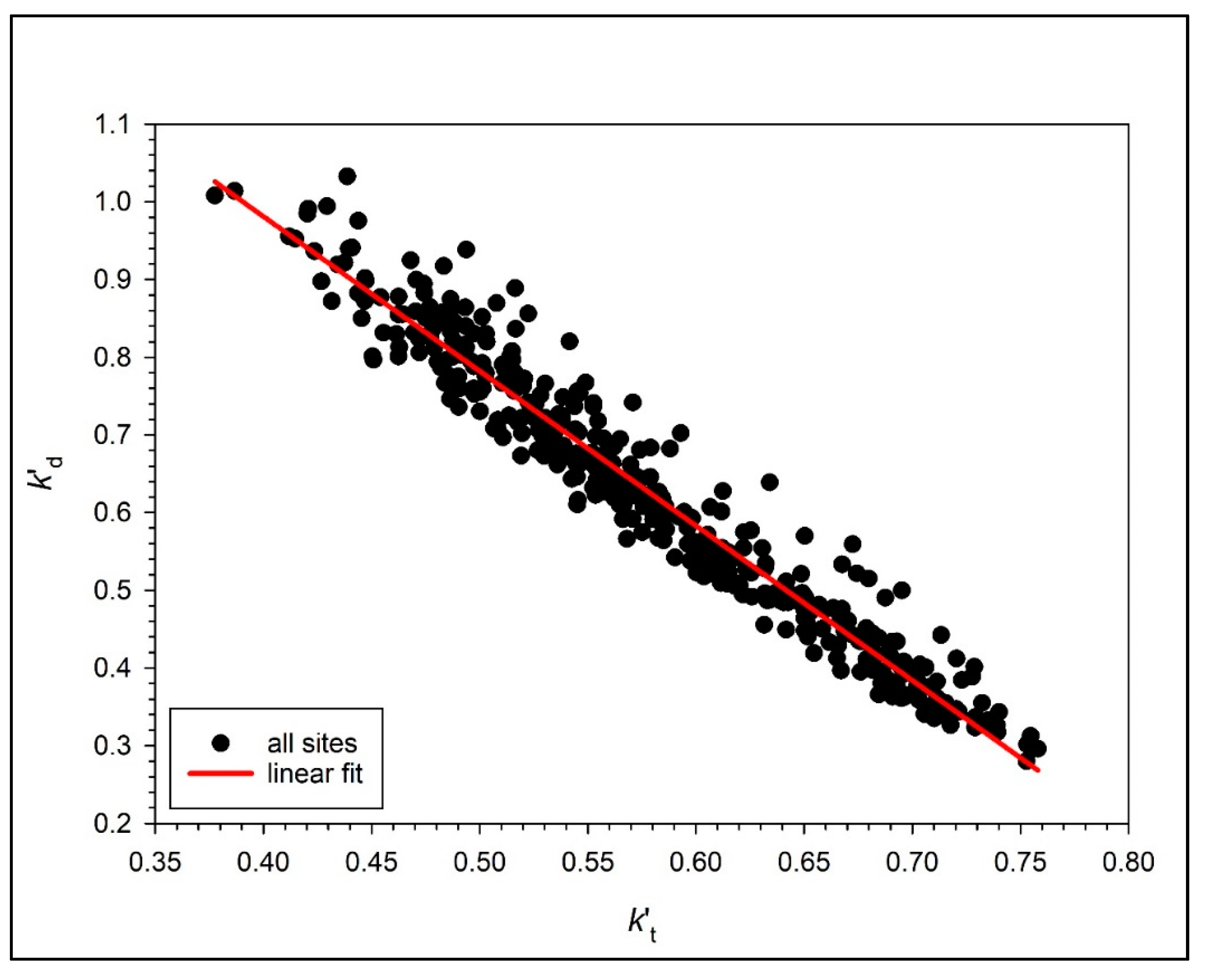
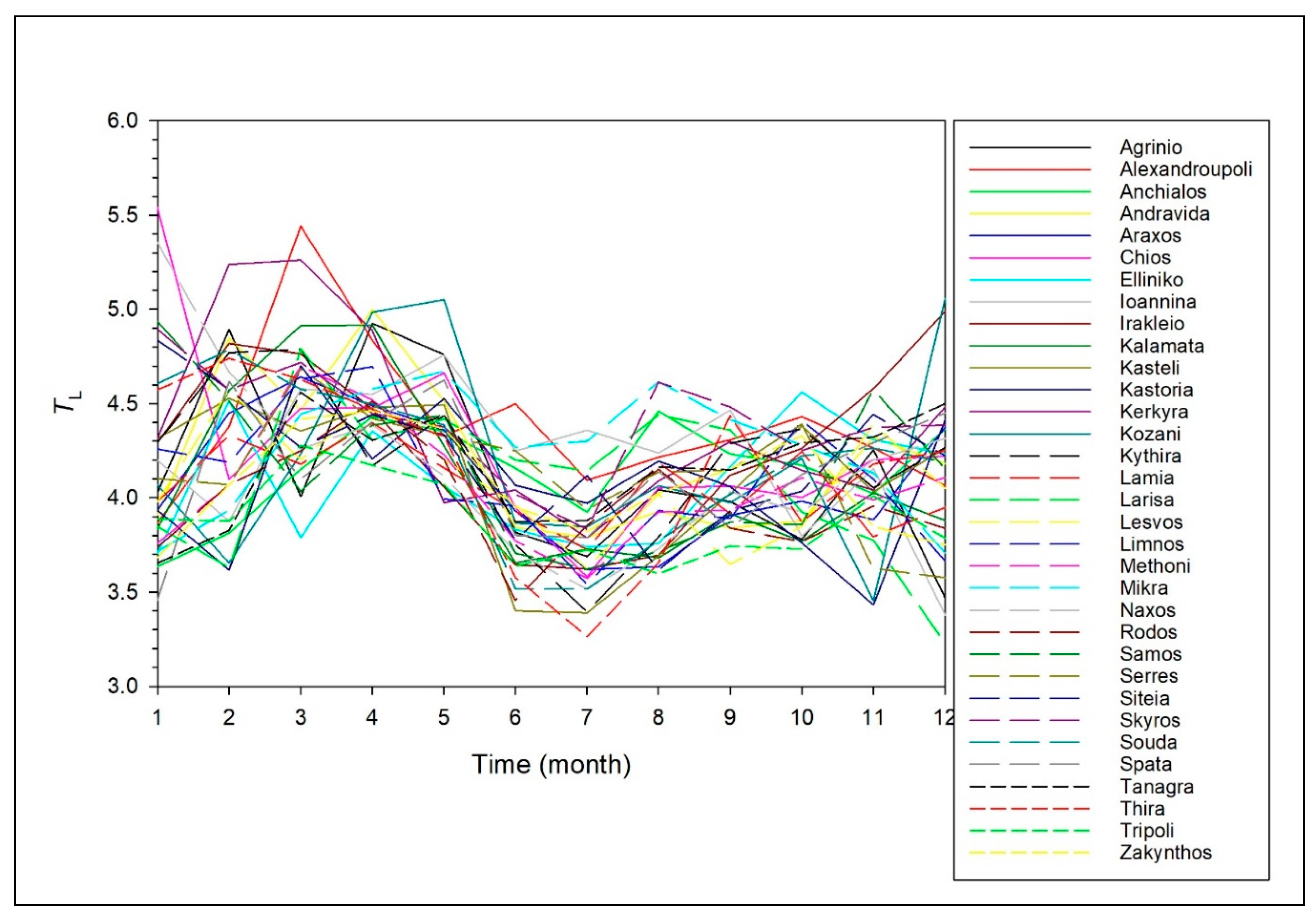
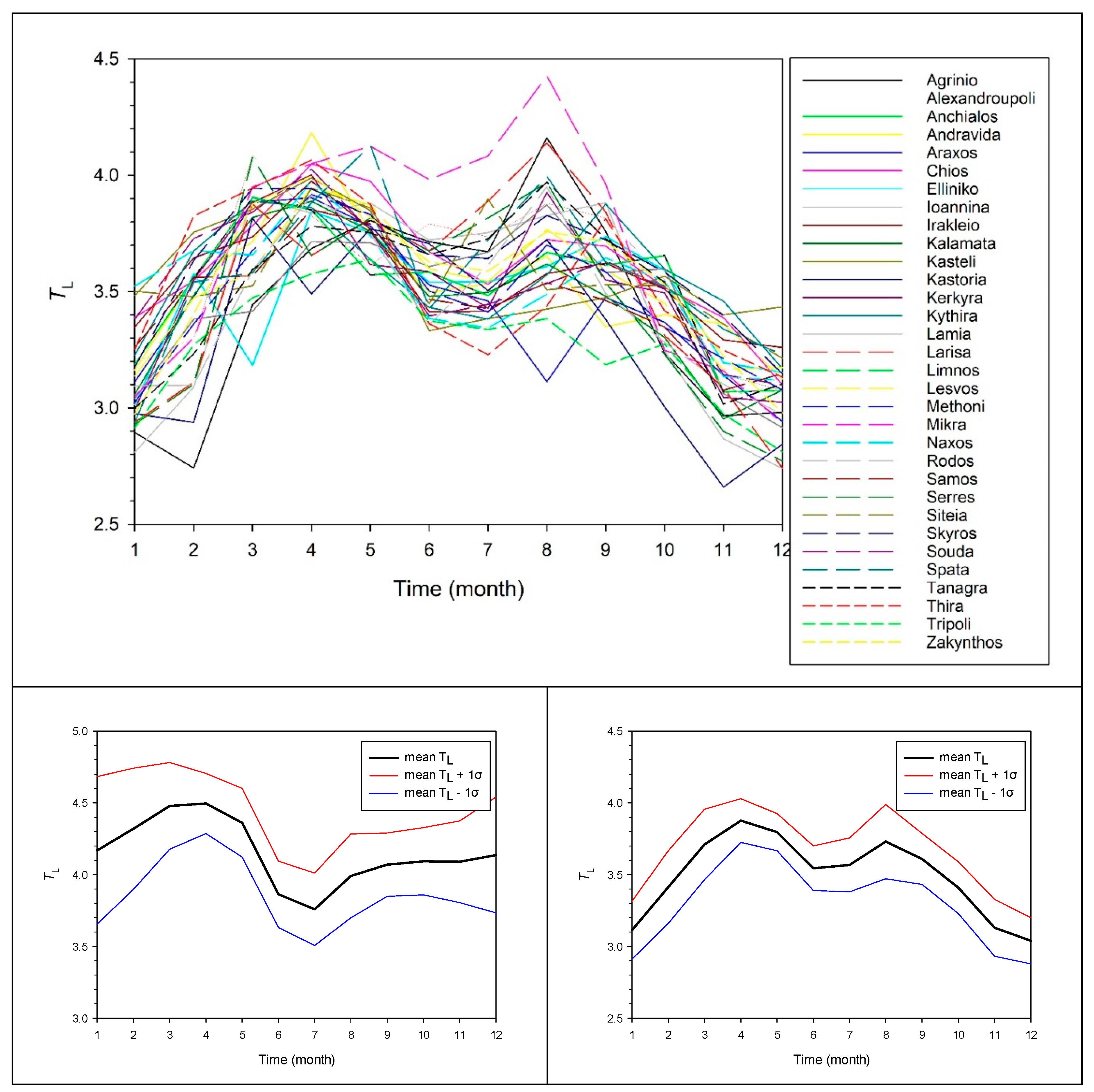


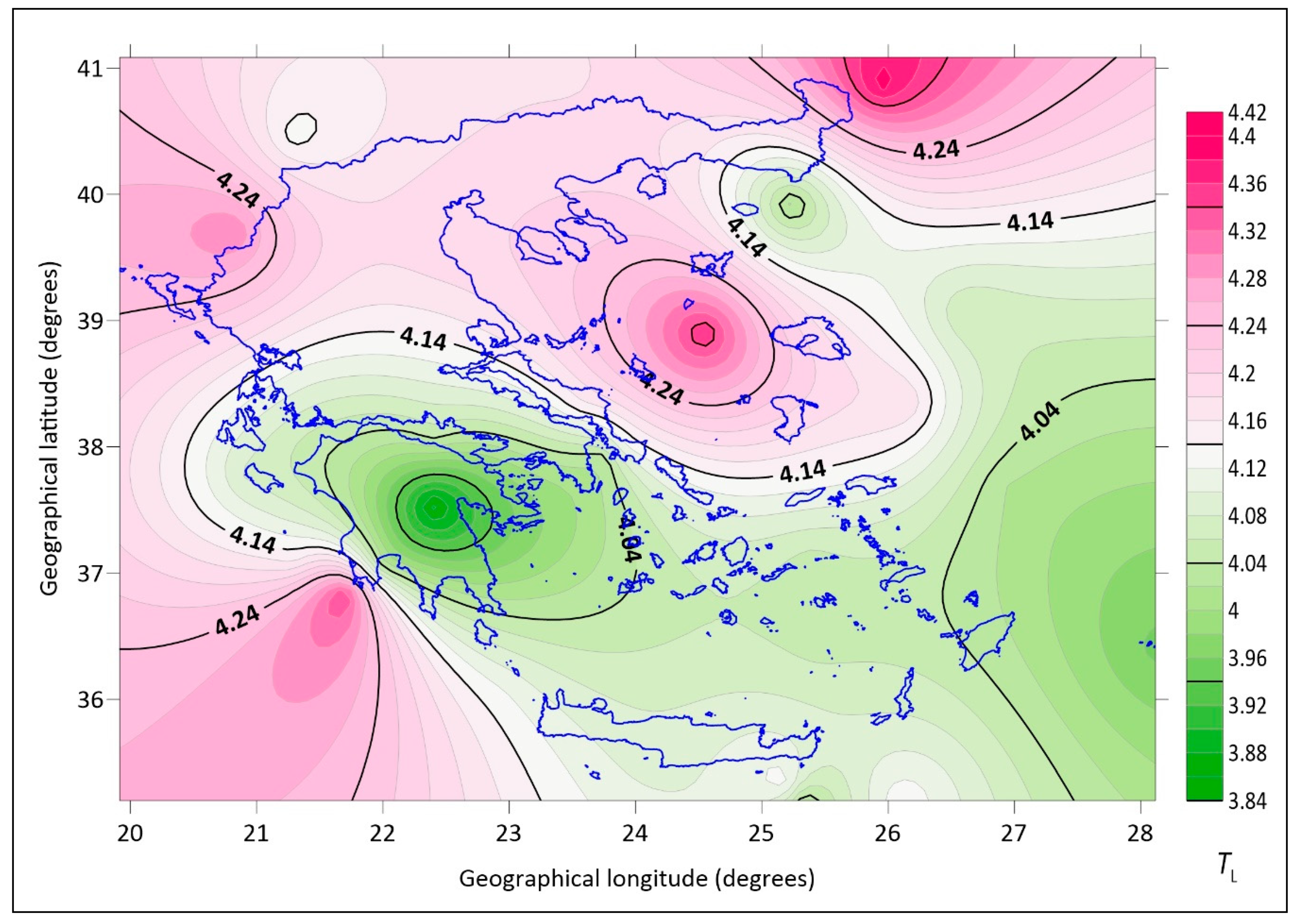
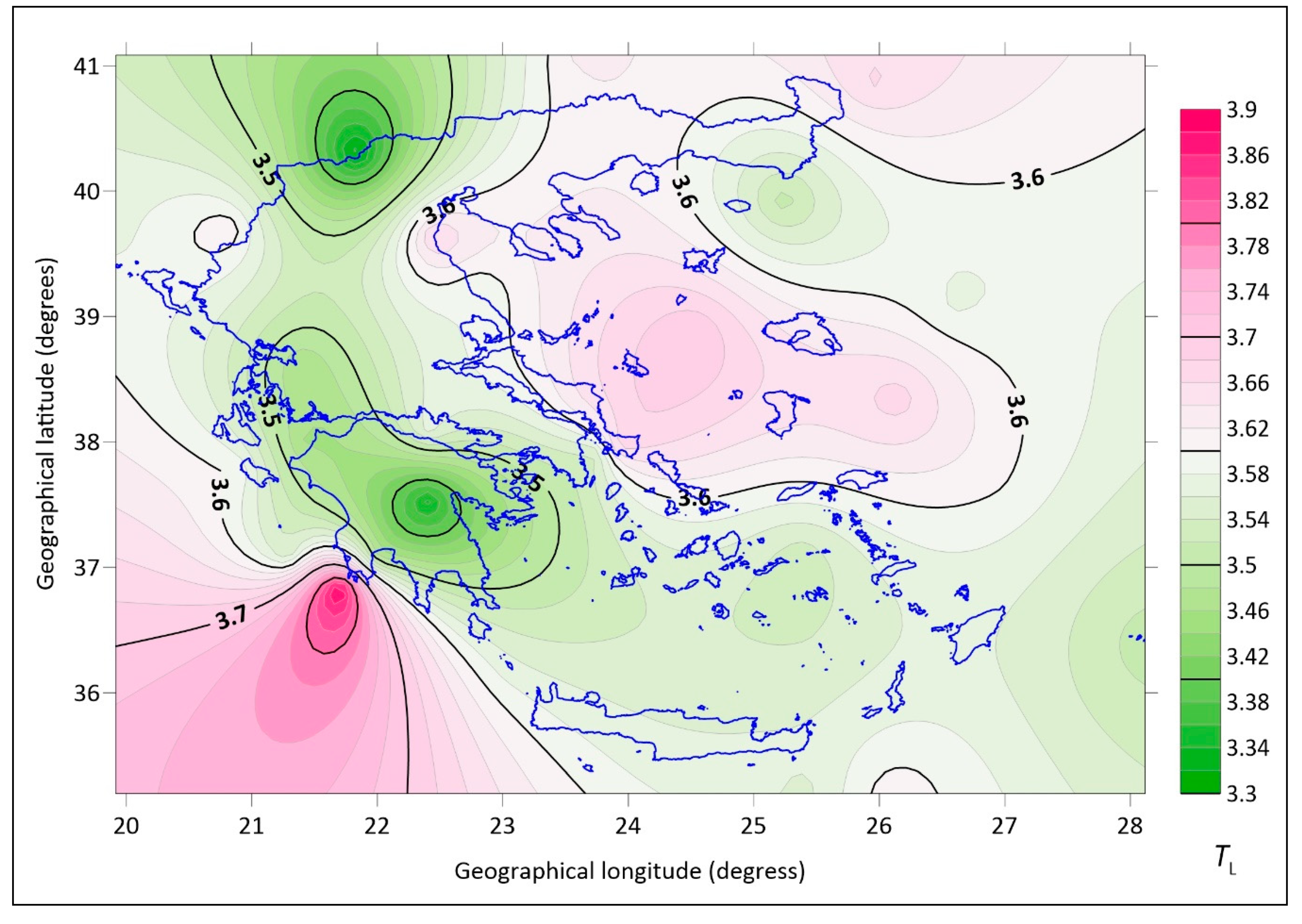
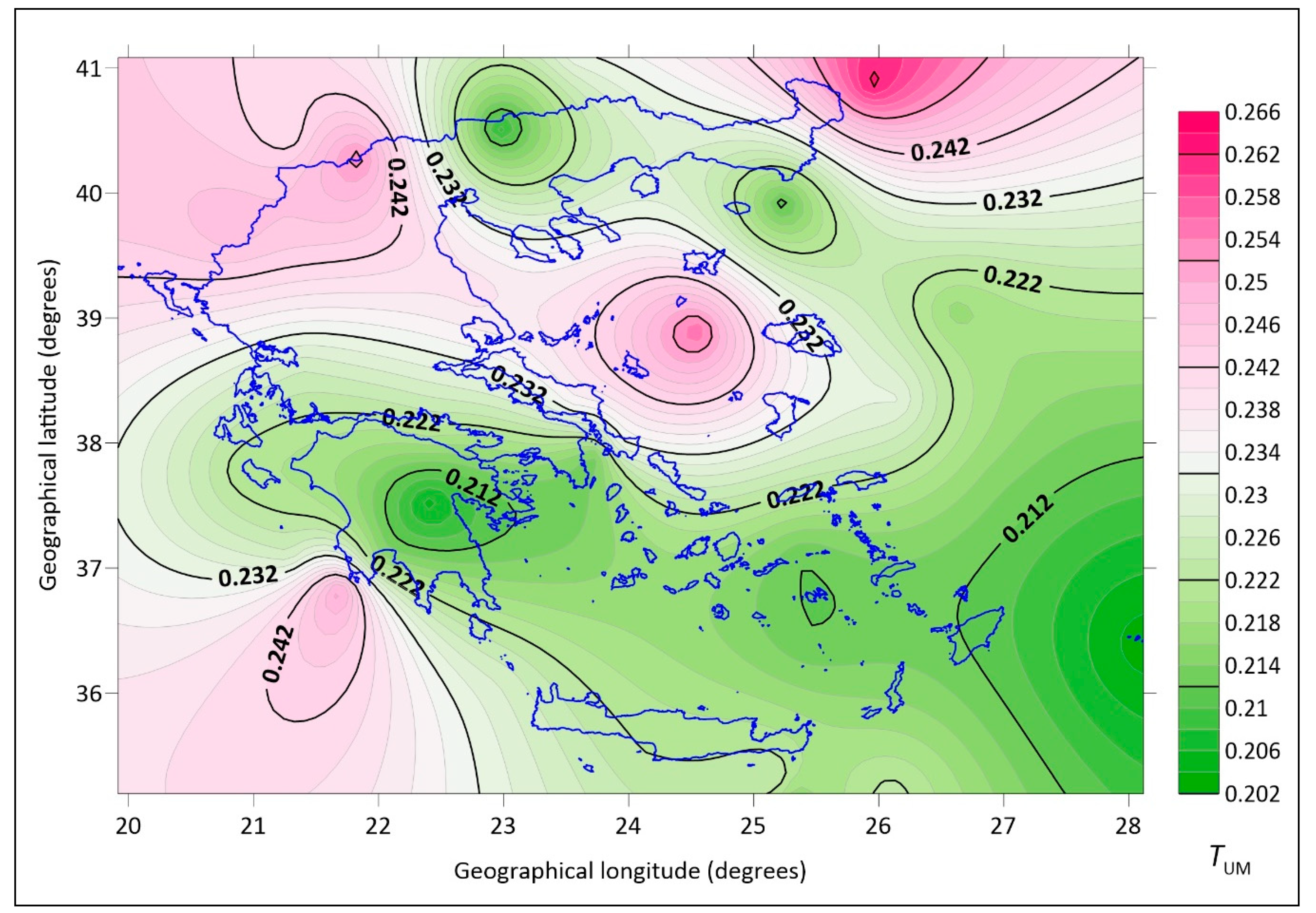


| Gas | A1 | A2 | A3 | A4 |
|---|---|---|---|---|
| H2O | 3.0140 | 119.300 | 0.6440 | 5.8140 |
| O3 | 0.2554 | 6107.26 | 0.2040 | 0.4710 |
| CO2 | 0.7210 | 377.890 | 0.5855 | 3.1709 |
| CO | 0.0062 | 243.670 | 0.4246 | 1.7222 |
| N2O | 0.0326 | 107.413 | 0.5501 | 0.9093 |
| CH4 | 0.0192 | 166.095 | 0.4221 | 0.7186 |
| O2 | 0.0003 | 476.934 | 0.4892 | 0.1261 |
| Station | Station Name (Region) | Station’s WMO Code (16xxx) | φ (Deg. N) | λ (Deg. E) | Climatic Zone | z (M amsl) |
|---|---|---|---|---|---|---|
| 1 | Serres (Central Macedonia) | 606 | 41.083 | 23.567 | D | 34.5 |
| 2 | Kastoria (Western Macedonia) | 614 | 40.450 | 21.283 | D | 660.9 |
| 3 | Mikra (outskirts of Thessaloniki, Central Macedonia) | 622 | 40.517 | 22.967 | C | 4.8 |
| 4 | Alexandroupoli (Eastern Macedonia and Thrace) | 627 | 40.850 | 25.933 | C | 3.5 |
| 5 | Kozani (Western Macedonia) | 632 | 40.283 | 21.783 | D | 625.0 |
| 6 | Kerkyra (known as Corfu, Ionian Islands) | 641 | 39.617 | 19.917 | A | 4.0 |
| 7 | Ioannina (Epirus) | 642 | 39.700 | 20.817 | C | 484.0 |
| 8 | Larisa (Thessaly) | 648 | 39.650 | 22.450 | C | 73.6 |
| 9 | Limnos (Northern Aegean) | 650 | 39.917 | 25.233 | B | 4.6 |
| 10 | Anchialos (Thessaly) | 665 | 39.217 | 22.800 | B | 15.3 |
| 11 | Lesvos (Northern Aegean) | 667 | 39.067 | 26.600 | B | 4.8 |
| 12 | Agrinio (Western Greece) | 672 | 38.617 | 21.383 | B | 25.0 |
| 13 | Lamia (Sterea Ellada) | 675 | 38.850 | 22.400 | B | 17.4 |
| 14 | Andravida (Western Greece) | 682 | 37.917 | 21.283 | B | 15.1 |
| 15 | Skyros (Sterea Ellada) | 684 | 38.900 | 24.550 | B | 17.9 |
| 16 | Araxos (Western Greece) | 687 | 38.133 | 21.417 | B | 11.7 |
| 17 | Tanagra (Sterea Ellada) | 699 | 38.317 | 23.550 | A | 139.0 |
| 18 | Chios (Northern Aegean) | 706 | 38.350 | 26.150 | B | 4.0 |
| 19 | Tripoli (Peloponnese) | 710 | 37.533 | 22.400 | C | 652.0 |
| 20 | Elliniko (Attica) | 716 | 37.900 | 23.750 | B | 15.0 |
| 21 | Zakynthos (known as Zante, Ionian Islands) | 719 | 37.783 | 20.900 | A | 7.9 |
| 22 | Samos (Northern Aegean) | 723 | 37.700 | 26.917 | A | 7.3 |
| 23 | Kalamata (Peloponnese) | 726 | 37.067 | 22.000 | A | 11.1 |
| 24 | Naxos (Southern Aegean) | 732 | 37.100 | 25.533 | A | 9.8 |
| 25 | Methoni (Peloponnese) | 734 | 36.833 | 21.700 | A | 52.4 |
| 26 | Spata (Attica) | 741 | 37.967 | 23.917 | B | 67.0 |
| 27 | Kythira (Attica) | 743 | 36.133 | 23.017 | A | 166.8 |
| 28 | Thira (Southern Aegean) | 744 | 36.417 | 25.433 | A | 36.5 |
| 29 | Souda (Crete) | 746 | 35.550 | 24.117 | A | 140.0 |
| 30 | Rodos (known as Rhodes, Southern Aegean) | 749 | 36.400 | 28.117 | A | 11.5 |
| 31 | Irakleio (also written as Heraklion, Crete) | 754 | 35.333 | 25.183 | A | 39.3 |
| 32 | Siteia (Crete) | 757 | 35.120 | 26.100 | A | 115.6 |
| 33 | Kasteli (Crete) | 760 | 35.120 | 25.333 | A | 335.0 |
| Climatic Zone | HDD (Dimensionless) | CDH (Dimensionless) | SSR (kWh m−2 y−1) |
|---|---|---|---|
| A | <1000 | [1300, 4500] | [1700, 1900] |
| B | [1000, 1500] | [2200, 5500] | [1500, 1700] |
| C | [1500, 2000] | [1200, 3800] | [1450, 1600] |
| D | ≥2000 | ≤1500 | ≤1500 |
| Climatic Zone | Site | a | b | R2 |
|---|---|---|---|---|
| B | Agrinio | 1.8616 | −2.1402 | 0.93 |
| C | Alexandroupoli | 1.7406 | −1.9311 | 0.92 |
| A | Irakleio | 1.7201 | −1.9172 | 0.99 |
| A | Kalamata | 1.6518 | −1.7932 | 0.91 |
| D | Kastoria | 2.0177 | −2.3781 | 0.94 |
| B | Lesvos | 1.7920 | −1.9125 | 0.98 |
| D | Serres | 1.8999 | −2.1945 | 0.94 |
| C | Tripoli | 1.8737 | −2.1123 | 0.96 |
© 2020 by the authors. Licensee MDPI, Basel, Switzerland. This article is an open access article distributed under the terms and conditions of the Creative Commons Attribution (CC BY) license (http://creativecommons.org/licenses/by/4.0/).
Share and Cite
Kambezidis, H.D.; Psiloglou, B.E. Climatology of the Linke and Unsworth–Monteith Turbidity Parameters for Greece: Introduction to the Notion of a Typical Atmospheric Turbidity Year. Appl. Sci. 2020, 10, 4043. https://doi.org/10.3390/app10114043
Kambezidis HD, Psiloglou BE. Climatology of the Linke and Unsworth–Monteith Turbidity Parameters for Greece: Introduction to the Notion of a Typical Atmospheric Turbidity Year. Applied Sciences. 2020; 10(11):4043. https://doi.org/10.3390/app10114043
Chicago/Turabian StyleKambezidis, Harry D., and Basil E. Psiloglou. 2020. "Climatology of the Linke and Unsworth–Monteith Turbidity Parameters for Greece: Introduction to the Notion of a Typical Atmospheric Turbidity Year" Applied Sciences 10, no. 11: 4043. https://doi.org/10.3390/app10114043
APA StyleKambezidis, H. D., & Psiloglou, B. E. (2020). Climatology of the Linke and Unsworth–Monteith Turbidity Parameters for Greece: Introduction to the Notion of a Typical Atmospheric Turbidity Year. Applied Sciences, 10(11), 4043. https://doi.org/10.3390/app10114043






